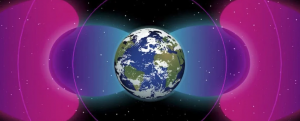Image Credit: NASA
As an amateur astronomer & SWL enthusiast, I always find it interesting when both disciplines overlap. I came across an article on the Internet posted by sciencealert.com of such an overlap.
The Earth is surrounded by two radiation belts (Van Allen Belts). But something strange has been discovered. After NASA launched a space probe in 2017 – and after analyzing collected data – the two Van Allen belts have been pushed farther away from Earth by a third “area”. That area is a “man-made barrier” created by Very Low Frequency (VLF) radio communications.
Scientists postulate this new man-made VLF barrier, a form of man-made Space Weather, has pushed the two radiation belts farther from Earth. And as such, this has created a “protective bubble” from potentially dangerous solar discharges and their radiation streams.
For those interested, you can read the full article here..
Guest post by Troy Riedel


This is fascinating, Troy! Thank you for sharing.
-Thomas
Looks like a dipole to me, or more accurately in 3D, a torus. Space is Electric……
1 MW VLF transmitter North West Cape, Western Australia.
https://nautilus.org/publications/books/australian-forces-abroad/defence-facilities/naval-communication-station-harold-e-holt-north-west-cape/
http://www.sws.bom.gov.au/IPSHosted/INAG/web-71/2010/wilkes.pdf
The notion that VLF communication has increased since the 1960s is also suspect.
Ah, Thomas, now I find out there yet another interest we share, astronomy. I am hoping I have a chance to live somewhere like Nevada or Arizona some day where I can really pursue that hobby and one more, model trains. Although, I think the later is more expensive than ham radio!
I’m skeptical about the conclusion of this article and the research that goes with it. First, there seems to be a major contradiction, “With frequencies between 3 and 30 kilohertz, they’re far too weak to carry audio transmissions, but they’re perfect for broadcasting coded messages across long-distances or deep underwater.” If VLF signals are so weak, how can they possibly affect the Van Allen Belt in any way? Would it not take a huge amount of energy, like that from a nuclear bomb, to affect the VAB at all?
The second question revolves around the nature of VLF signal propagation. It hugs the earth’s surface even to the point of following that surface into the sea. That’s what makes it so valuable for submarine communications. I assume the antennas used by the Navy and others are designed to perpetuate and enhance this feature of VLF. That means that very little energy is going to leave the earth and head out into space.
So, you have weak signals with low energy (even though the transmitters range from about 100kw to 1000kw, it appears) that tend to hug the earth but somehow impact the Van Allen Belt and affect space weather. Is this science fiction? Inquiring minds want to know…
Hi, Dan, Actually, it’s our resident astronomer, Troy Riedel, who shared this fascinating piece. With that said, I’ve always loved astronomy and one of my daughters is a budding astronomer. Indeed, she loves anything/everything dealing with space. Her vanity callsign, for example, is K4TLI (Trans-Lunar Injection).
FYI: Years ago, Troy actually produced a one episode broadcast called The Amateur Astronomer.
And trains? I have no skill to build scenery, etc., but I will attempt to build a model railway in a vintage suitcase at some point. Something like this: http://suitcasetrains.com/
Cheers,
Thomas
I also had to chuckle at this gem:
“…but it turns out they’ve been leaking into the space surrounding our planet, and have lingered long enough to form a giant protective bubble.”
Radio waves don’t “linger” anywhere. They travel at the speed of light!